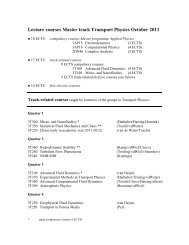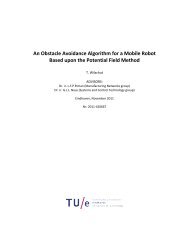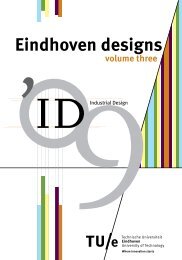Biomedical Engineering - Technische Universiteit Eindhoven
Biomedical Engineering - Technische Universiteit Eindhoven
Biomedical Engineering - Technische Universiteit Eindhoven
Create successful ePaper yourself
Turn your PDF publications into a flip-book with our unique Google optimized e-Paper software.
Profile<br />
Education<br />
Research<br />
There is an endless demand in modern healthcare for technologies to improve the diagnosis,<br />
treatment and prevention of health problems. To meet this demand, the <strong>Eindhoven</strong> University<br />
of Technology (TU/e) focuses a great deal of its research and education on health technologies<br />
and has a department devoted entirely to this socially vital area: <strong>Biomedical</strong> <strong>Engineering</strong>.<br />
<strong>Biomedical</strong> engineers improve human health through cross-disciplinary activities that integrate<br />
the engineering sciences with the biomedical sciences and clinical practice.<br />
<strong>Biomedical</strong> <strong>Engineering</strong> (BME) is a familiar discipline around the world, but there are many<br />
different types of programs. In 1997 TU/e was one of the first universities to introduce an integrated<br />
five-year BME program leading to a master’s degree. From the outset, the curriculum integrates<br />
the natural sciences and engineering disciplines with cell biology and pathophysiology.<br />
It is also designed to meld seamlessly with the research in our own department.<br />
Research ranges from regenerative medicine to image anaylsis to molecular<br />
engineering. The research is performed in eight specialized research groups that<br />
cooperate in several mutual projects, such as developing an artificial human<br />
kidney and designing personalized medicines.<br />
Synergy of education and research<br />
The Department of <strong>Biomedical</strong> <strong>Engineering</strong> provides<br />
high-quality academic education and cutting-edge research.<br />
• Education<br />
One bachelor’s track, <strong>Biomedical</strong> <strong>Engineering</strong>, and two<br />
master’s tracks, <strong>Biomedical</strong> <strong>Engineering</strong> and Medical<br />
<strong>Engineering</strong>.<br />
• Research<br />
performed in eight specialized research groups and covers<br />
everything from regenerative medicine to image analysis<br />
to molecular engineering.<br />
Contact between the 300 undergraduate students, 200<br />
graduate students and 180 researchers is open and personal.<br />
This allows the students to have good interaction with the<br />
scientists and medical specialists. As a result, our students<br />
are capable of performing and coordinating basic and applied<br />
scientific research in the field of biomedical engineering from<br />
a very early stage in their careers. The close collaboration<br />
between our researchers also fosters cooperation between<br />
research groups in numerous shared projects, such as the<br />
development of an artificial human kidney and the design of<br />
personalized medicines.<br />
“To discover why these diseases develop is a<br />
key driver for me.” Prof.dr.ir. Luc Brunsveld, Chemical Biology /<br />
Department of <strong>Biomedical</strong> <strong>Engineering</strong><br />
Partners in health<br />
The Department of <strong>Biomedical</strong> <strong>Engineering</strong> collaborates<br />
closely with other health-oriented departments at TU/e, other<br />
universities, academic hospitals and industrial partners. Much<br />
of this collaboration occurs through international contacts in<br />
countries such as China, the U.S.A., Australia and European<br />
countries.<br />
Bachelor’s program<br />
The three-year bachelor’s program focuses on research and<br />
development and offers a broad range of knowledge and skills.<br />
Students take courses on mathematics, physics, chemistry,<br />
electrical engineering, mechanical engineering, computer<br />
science, physiology and biology. From day one, they work<br />
together in teams on state-of-the-art biomedical problems,<br />
so that they also develop such valuable skills as cooperation,<br />
communication and reporting. The students are guided by<br />
graduate students, post-docs and academic staff, including<br />
professors, in these projects.<br />
Besides the fixed parts of the bachelor’s program, students<br />
choose their own track. Many students choose to broaden<br />
their scope by studying another field of research, perhaps<br />
at another university or even abroad. Popular tracks are<br />
Medicine and Management Sciences.<br />
Master programs<br />
When it comes time to move on to a master’s degree program,<br />
there are plenty of appropriate ones to choose from at other<br />
universities. Students who have taken specific medical<br />
elective courses are eligible to the admission procedure of<br />
the Selective Utrecht Medical Master (SUMMA) program at<br />
Utrecht University, the Arts-Klinisch Onderzoeker program<br />
(AKO) of the University at Maastricht, and the Medical Masters<br />
programs in Groningen (ZIG) and Amsterdam. However, most<br />
students decide to follow a master program that belongs to<br />
the Life Sciences and <strong>Engineering</strong> graduate program. This TU/e<br />
graduate program includes the master program <strong>Biomedical</strong><br />
<strong>Engineering</strong> and the master program Medical <strong>Engineering</strong>.<br />
<strong>Biomedical</strong> <strong>Engineering</strong><br />
The Master in <strong>Biomedical</strong><br />
<strong>Engineering</strong> is strongly<br />
research focused and aims to<br />
develop general solutions for<br />
a patient group. <strong>Biomedical</strong><br />
engineers specialize in one<br />
particular field relevant to<br />
clinical problems.<br />
Medical <strong>Engineering</strong><br />
The Master in Medical<br />
<strong>Engineering</strong> aims to<br />
integrate advanced medical<br />
technologies into clinical<br />
practice. Medical engineers<br />
develop solutions to clinical<br />
problems. They solve patient<br />
specific problems, through<br />
models and technologies.<br />
At the start of both master programs, students become a<br />
member of one of our eight research groups. They design their<br />
own personal curriculum in cooperation with a professor. Most<br />
students go abroad for a three-to-four-month internship as part<br />
of the program, with popular destinations being the U.S.A. and<br />
Australia. In fact, the study materials for both the bachelor’s<br />
and master programs are in English, so all students are wellprepared<br />
for an international career.<br />
Careers for a biomedical engineer<br />
Most graduates will start working as a researcher after<br />
finishing their master <strong>Biomedical</strong> <strong>Engineering</strong> or Medical<br />
<strong>Engineering</strong>. But some of them become: developer, project<br />
manager, lecturer, salesman, advisor...<br />
The sectors and companies that graduates (after their master)<br />
work in can be found in the diagram below.<br />
• Universities (PhD students) (30%)<br />
• (Academic) Hospitals (22%)<br />
• Development of medical<br />
products (16%)<br />
• Pharmaceutical companies (10%)<br />
• Small companies (10%)<br />
• National research institutes (5%)<br />
• Organisation and finances (5%)<br />
• Other (2%)<br />
As there is always more to learn, graduates may continue<br />
studying. They often choose for an education program at<br />
the School for medical Physics and <strong>Engineering</strong> to become a<br />
clinical physicist, a qualified medical engineer or qualified<br />
medical Informatics professional. Or they choose a four year<br />
research program to become a PhD.<br />
“In my biomedical engineering study, I learned<br />
to discuss with all kind of engineers at a high<br />
level and to quickly identify the innovative<br />
aspects of inventions. This boosted my career<br />
as a consultant and enables me to efficiently<br />
translate technical ideas into commercial<br />
products.” Jasper Levink, Business development<br />
consultant, ttopstart<br />
Soft Tissue Biomechanics and<br />
<strong>Engineering</strong><br />
Prof.dr.ir. Frank Baaijens &<br />
Prof. dr. Carlijn Bouten<br />
Through experimentation and numerical<br />
modeling, we study how living tissues<br />
adapt to mechanical loading. We apply<br />
the knowledge of tissue proliferation<br />
and differentiation thus obtained to<br />
biomedical problems such as prosthesis<br />
design, pressure ulcers and the<br />
engineering of living tissues and organs<br />
(e.g., heart valves and intervertebral<br />
discs).<br />
Cardiovascular Biomechanics<br />
Prof.dr.ir. Frans van de Vosse<br />
We develop experimental and<br />
computational models of the cardiovascular<br />
system for the purpose of<br />
supporting medical decision making<br />
in clinical practice. The models can be<br />
used in the development of methods<br />
for quantitative measurements (e.g.,<br />
pressure, flow, and tissue deformation)<br />
and to predict the outcome of medical<br />
intervention (e.g., surgery and<br />
medication).<br />
Orthopaedic Biomechanics<br />
Prof.dr. Keita Ito<br />
We combine engineering and biology<br />
to expand our understanding of the<br />
biomechanical function of musculoskeletal<br />
tissues, as well as their adaptive<br />
developmental and physiological nature.<br />
Our investigations of degenerative<br />
diseases and regenerative treatment<br />
strategies target the three tissues bone,<br />
articular cartilage and intervertebral disc.<br />
<strong>Biomedical</strong> Image Analysis<br />
Prof.dr.ir. Bart ter Haar Romenij<br />
We develop new robust image analysis<br />
algorithms for computer-aided diagnosis<br />
and interactive 3D visualization to help<br />
in extracting quantitative information<br />
from medical images. We apply these<br />
techniques to practical clinical problems,<br />
with an emphasis on the cardiovascular<br />
system (3D deformation, ablation,<br />
4D flow, interventions) and the brain<br />
(tractography, surgery navigation).<br />
Biomodeling & Bioinformatics<br />
Prof.dr. Peter Hilbers<br />
We investigate and apply molecular<br />
modeling methods, machine learning,<br />
systems biology and parameter<br />
estimation techniques to construct<br />
computational models. With these<br />
models, we improve our qualitative and<br />
quantitative knowledge of biomedical<br />
processes and structures, such as<br />
biomembranes, protein interactions<br />
and complex biochemical networks, and<br />
diseases, such as metabolic syndrome<br />
and diabetes mellitus.<br />
Chemical Biology<br />
Prof.dr.ir. Luc Brunsveld<br />
We apply novel chemistry techniques to<br />
biology to enhance our understanding<br />
of diseases on the molecular level and<br />
develop new or personalized drugs.<br />
Our targets of interest are studies of<br />
the nuclear receptors that play a role<br />
in cancer and the visualization and<br />
assembly processes of proteins, such as<br />
disease relevant membrane proteins.<br />
<strong>Biomedical</strong> Chemistry<br />
Prof.dr. Bert Meijer<br />
Our aim is to develop new molecular<br />
tools and biomaterials for biomedical<br />
research using supramolecular<br />
interactions. We create new materials<br />
for tissue engineering (e.g., an artificial<br />
kidney), novel peptide-based scaffolds<br />
for drug delivery, and proteins with<br />
attractive biomedical properties for<br />
molecular imaging. We focus on artificial<br />
structures that are indistinguishable<br />
from their natural counterparts.<br />
<strong>Biomedical</strong> NMR<br />
Prof.dr. Klaas Nicolay<br />
We develop non-invasive imaging<br />
techniques to improve the diagnosis and<br />
treatment of cardiovascular diseases,<br />
metabolic disorders and cancer. Our<br />
research focuses on expanding the<br />
capabilities of Magnetic Resonance<br />
Imaging (MRI) and Spectroscopy (MRS).<br />
Following initial validation in preclinical<br />
studies, we aim to translate promising<br />
methods into clinical use.

















